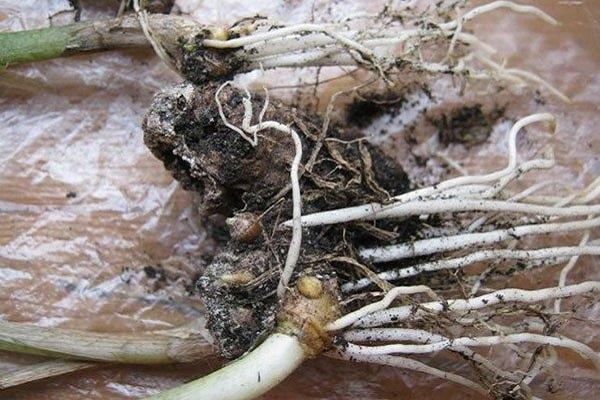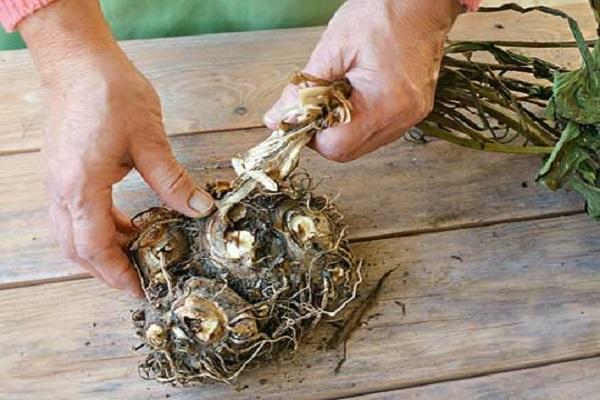When to dig up and how to properly store calla lilies at home in winter
Calla lilies are graceful perennial flowers that can effectively decorate a garden or summer cottage. Gardeners grow them not only at home, in a pot culture, but also simply in the open field. To preserve a delicate plant that does not tolerate winter well, every grower should know the main thing about calla lilies - when to dig them up, where and how to safely store them until spring.
Content
- 1 Do I need to dig up garden calla lilies for the winter
- 2 When to dig calla lilies from open ground in the fall
- 3 Stages of preparation for wintering
- 4 Necessary conditions for wintering a plant
- 5 Methods for storing plants after digging up at home
- 6 How to store calla bulbs until spring in an apartment
- 7 Spring planting of tubers
Do I need to dig up garden calla lilies for the winter
These flowers, despite their southern origin, are not overly capricious, even when grown in more northern climates. But for the winter, it is recommended to dig up tubers - a small minus, not to mention severe frosts, can easily destroy the plant. Plus, for the flowering of tuberous calla lilies, a mandatory period of "cool dormancy" is needed, this also applies to many indoor varieties.
In the southern regions, some gardeners leave the rhizomes and tubers to winter in the ground, covering it well with mulch. But this technique usually does not bring anything positive. It's like playing roulette. In recent years, winters have been unpredictable even in the south. It is safer, and even more effective, to harvest calla lilies tubers for the winter. Moreover, this agricultural practice allows you to examine the bulbs after digging, in time to identify the onset of diseases. The very same cleaning of plants from the garden takes place in several stages.
When to dig calla lilies from open ground in the fall
For successful wintering, the tubers must be excavated on time. If you dig up a still growing plant early, it will not be able to successfully overwinter, and delaying the timing until the onset of frost can simply ruin the flower.
Depending on the variety
There are 8 types of calla lilies in nature. They are divided into 2 main subspecies - rhizome and tuberous. Calla lilies of Elliot and Remani are referred to as tuberous. These species shed their foliage during the dormant period. Calla Ethiopian belongs to the rhizome, which does not shed its foliage during the period of "hibernation" and does not have a pronounced dormant period.
Tuberous calla lilies more susceptible to low temperatures are dug out first. But rhizome plants can tolerate a small minus. But you should also not delay with their digging.

Depending on the region of growth
The timing depends on the region of cultivation and on how the cold comes in early autumn.Usually, the excavation is carried out in the southern regions from the beginning of October, and in the Central zone, including the Moscow region, from the second half of September. And in more northern regions, training begins at the beginning of the month.
Stages of preparation for wintering
Callas need to be prepared for digging in stages. The gardener, in order to preserve the plant in winter, must clearly know what to do and when.
Flower preparation and the digging process itself
The onset of frost signals the flower about the end of the growing season and preparation for hibernation. After frost, all dried leaves are cut off, leaving only petioles 5-7 centimeters each. Autumn is the time for rains, so be sure to protect the flowers from unwanted moisture. Usually, lightweight shelters are built from sheets of iron, slate, greenhouse film. Gardeners stop watering calla lilies 2-3 weeks before digging.

When digging itself, it is best to use a pitchfork. When using a glanders or shovel, there is a high probability of damaging, cutting or leaving part of the tubers in the ground. In order to get the bulbs as safely as possible, a hole is dug out of a slightly larger diameter than the size of the root calla.
Drying the tubers
After digging, the tubers are cleaned of soil. The best way is to place them in a container with liquid, and after a short soaking, wash them under a weak stream of water. It is necessary to clean the dirt in this way carefully so as not to break off poorly formed children.
After cleaning, they inspect the tubers, discard the spoiled, sick, rotten ones.

With minor damage, the tubers are cut to elastic, healthy tissue. The cleaned places are powdered with charcoal, and all the bulbs are placed to dry. Tubers are laid out in a thin layer in small cardboard, foam or plastic boxes. The bottom of the boxes is lined with newspapers or old agrofibre, which absorbs excess moisture well. Drying is carried out in a dark, cool, well-ventilated area.
It is necessary to maintain a constant temperature of +20 C, +25 C degrees, only then they will dry out thoroughly. Tubers are dried for about 2, maximum 3 weeks. After the bulbs are dried, they are laid for permanent storage until spring.

The dormant period for tubers lasts until the end of March. During storage, periodic inspections of the planting material are carried out. This will help in time to detect sick, rotten bulbs and protect everyone else from damage. In the case of rhizome calla lilies, they are placed in a cool place along with the pots. When digging from open ground, sprinkle with a wet substrate and also place it for the winter in a cool place.

Necessary conditions for wintering a plant
For a correct and safe wintering, several conditions must be met. Moreover, the fulfillment of these conditions by the gardener should be mandatory.
- In winter, when storing tubers, the temperature should be in the range from +5 C to +10 C degrees.
- Conducting humidity control. Storing tubers and rhizomes in dry rooms will prevent rot and possible plant death.
- Store plants in a well and regularly ventilated area.
- Periodic sanitary examinations to help keep the planting material healthy, to detect the onset of the disease in time.
- When storing calla lilies rhizomes in a substrate or pots, it is necessary to monitor its moisture content.
- In rhizome calla lilies, care is reduced to periodic light moistening of the substrate.
- In tuberous calla lilies, to prevent premature growth, leaves and roots are removed.
- Tubers must be properly dried before storing. The safety of planting material in winter depends on this.
For successful wintering, it is advisable to sprinkle the tubers (bulbs) so that they do not come into contact with each other with one of the materials:
- peat;
- small wood chips;
- sphagnum moss;
- sand.

Methods for storing plants after digging up at home
There are several ways to store calla tubers until spring. An important point - before laying for the winter, all the roots are cut off, otherwise the flower can grow.
Content in the basement
The tubers are placed in the basement. Successful storage depends on the maintained correct temperature regime, it ranges from +5 C to +10 C degrees. In no case should the temperature increase, this will lead to a premature, early onset of germination of the bulbs.
High humidity is detrimental to the planting material, so storage should be "dry". The basement itself must be ventilated with a constant supply of fresh air. Otherwise, the bulbs will simply spray.

Accommodation for the winter on the loggia
This storage method is suitable for gardeners who grow calla lilies in a pot culture. In the fall, watering is gradually reduced, and after the first frost and the death of the leaves, the pots are transferred to a glazed balcony or loggia. Calla lilies stay there until spring. It is important to control the temperature regime - in severe frosts, it is advisable to additionally cover the pots. And vice versa - it is desirable that there is no heating on the balcony, otherwise the calla lilies will grow.
How to store calla bulbs until spring in an apartment
If there is no other way out, but it is necessary to save the bulbs, then you can use an ordinary apartment as a storage place. With this method, a box of tubers is placed in the coolest place, near a window or balcony door.
But it is necessary, if possible, to isolate the bulbs from the warm air of the room; it is important to place them away from the radiators. At temperatures above +20 C degrees, the tubers can overwinter, but they dry out and wrinkle, and this will affect the health of the plant in the future and the abundance of flowering. And at elevated temperatures and high humidity, the tubers will quickly grow.

In a refrigerator
If there are few tubers, then a regular home refrigerator can be used for storage. The bulbs are wrapped in paper or newspaper, sprinkled with sawdust, and then placed in the lower compartment of the refrigerator, where vegetables are usually stored. With this type of storage, periodic inspections of the condition of the tubers are also necessary.
Spring planting of tubers
After winter comes the favorite season of gardeners - spring, the time of planting seedlings and seedlings. Calla lilies are no exception. Disembarkation begins after the threat of severe frosts has passed. In the Central lane, calla lilies are usually planted in early May, in the southern regions - from mid-April.
Before planting, a preventive examination is carried out after storage. Tubers should be healthy, firm and firm. All sick, severely rotten, dried tubers are discarded. If the lesion is insignificant, the sore spot is cut out to healthy tissue, and the cut site is crushed with charcoal.

Before planting itself, it is advisable to disinfect the planting material. A pink solution of potassium permanganate is used, where the bulbs are placed for 30 minutes. You can use special preparations with which planting potatoes are usually pickled. These are the already proven Prestige and Maxim.
The bed is pre-dug up and granular complex mineral fertilizers are applied, 25-30 grams per 1 square meter. The depth of the landing pit is 5-10 centimeters. The distance between plants is from 30 to 50 centimeters, depending on the vigor of the variety. There should be enough space around for the calla lilies to grow. It is advisable to plant in shaded areas, they must be protected from direct, scorching rays of the sun.

Immediately upon planting, the tuber is placed in a hole, covered with soil and spilled well with water.In the absence of sprouts, it is not worth worrying about prematurely and trying to dig up the tubers - the first sprouts in calla lilies appear only after 2-4 weeks.
At first, their root system begins to grow, and then the aerial part will begin to actively grow. Some gardeners plant tubers in pots first. In March and early April, calla lilies are placed in pots with a substrate, and then - in May, they are already transplanted with a lump of earth into open ground.









